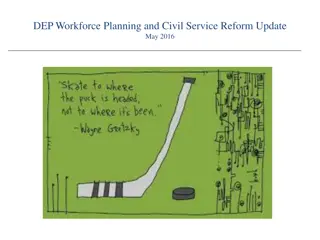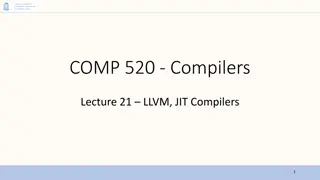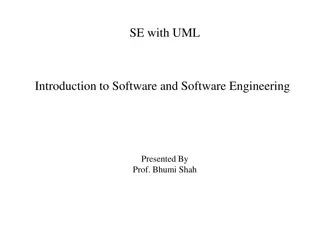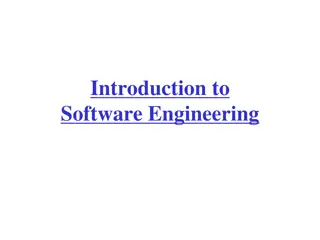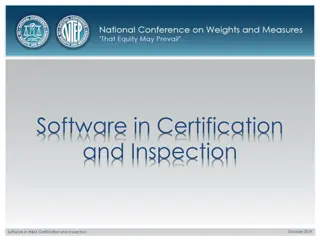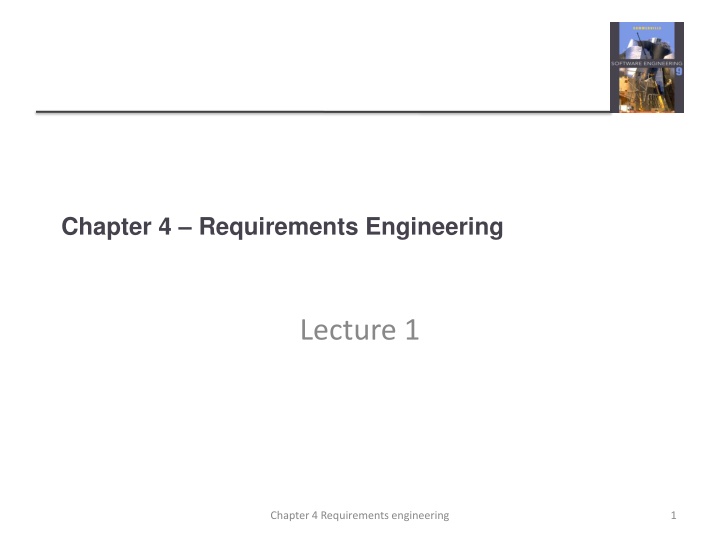
Requirements Engineering in Software Development
Explore the crucial process of requirements engineering in software development, encompassing the establishment of services needed by customers and operational constraints. Learn about different types of requirements and their significance in project development.
Download Presentation

Please find below an Image/Link to download the presentation.
The content on the website is provided AS IS for your information and personal use only. It may not be sold, licensed, or shared on other websites without obtaining consent from the author. If you encounter any issues during the download, it is possible that the publisher has removed the file from their server.
You are allowed to download the files provided on this website for personal or commercial use, subject to the condition that they are used lawfully. All files are the property of their respective owners.
The content on the website is provided AS IS for your information and personal use only. It may not be sold, licensed, or shared on other websites without obtaining consent from the author.
E N D
Presentation Transcript
Chapter 4 Requirements Engineering Lecture 1 Chapter 4 Requirements engineering 1
Requirements engineering The process of establishing the services that the customer requires from a system and the constraints under which it operates and is developed. The requirements themselves are the descriptions of the system services and constraints that are generated during the requirements engineering process. Chapter 4 Requirements engineering 2
What is a requirement? It may range from a high-level abstract statement of a service or of a system constraint to a detailed mathematical functional specification. This is inevitable as requirements may serve a dual function May be the basis for a bid for a contract - therefore must be open to interpretation; May be the basis for the contract itself - therefore must be defined in detail; Both these statements may be called requirements. Chapter 4 Requirements engineering 3
Requirements abstraction (Davis) If a company wishes to let a contract for a large software development project, it must define its needs in a sufficiently abstract way that a solution is not pre-defined. The requirements must be written so that several contractors can bid for the contract, offering, perhaps, different ways of meeting the client organization s needs. Once a contract has been awarded, the contractor must write a system definition for the client in more detail so that the client understands and can validate what the software will do. Both of these documents may be called the requirements document for the system. Chapter 4 Requirements engineering 4
Types of requirement User requirements Statements in natural language plus diagrams of the services the system provides and its operational constraints. Written for customers. System requirements A structured document setting out detailed descriptions of the system s functions, services and operational constraints. Defines what should be implemented so may be part of a contract between client and contractor. Chapter 4 Requirements engineering 5
User and system requirements Chapter 4 Requirements engineering 6
Readers of different types of requirements specification Chapter 4 Requirements engineering 7
Functional and non-functional requirements Functional requirements Statements of services the system should provide, how the system should react to particular inputs and how the system should behave in particular situations. May state what the system should not do. Non-functional requirements Constraints on the services or functions offered by the system such as timing constraints, constraints on the development process, standards, etc. Often apply to the system as a whole rather than individual features or services. Chapter 4 Requirements engineering 8
Functional requirements Describe functionality or system services. Depend on the type of software, expected users and the type of system where the software is used. Functional user requirements may be high-level statements of what the system should do. Functional system requirements should describe the system services in detail. Chapter 4 Requirements engineering 9
Functional requirements for the MHC-PMS A user shall be able to search the appointments lists for all clinics. The system shall generate each day, for each clinic, a list of patients who are expected to attend appointments that day. Each staff member using the system shall be uniquely identified by his or her 8-digit employee number. Chapter 4 Requirements engineering 10
Requirements imprecision Problems arise when requirements are not precisely stated. Ambiguous requirements may be interpreted in different ways by developers and users. Consider the term search in requirement 1 User intention search for a patient name across all appointments in all clinics; Developer interpretation search for a patient name in an individual clinic. User chooses clinic then search. Chapter 4 Requirements engineering 11
Requirements completeness and consistency In principle, requirements should be both complete and consistent. Complete They should include descriptions of all facilities required. Consistent There should be no conflicts or contradictions in the descriptions of the system facilities. In practice, it is impossible to produce a complete and consistent requirements document. Chapter 4 Requirements engineering 12
Non-functional requirements These define system properties and constraints e.g. reliability, response time and storage requirements. Constraints are I/O device capability, system representations, etc. Process requirements may also be specified mandating a particular IDE, programming language or development method. Non-functional requirements may be more critical than functional requirements. If these are not met, the system may be useless. Chapter 4 Requirements engineering 13
Types of nonfunctional requirement Chapter 4 Requirements engineering 14
Non-functional requirements implementation Non-functional requirements may affect the overall architecture of a system rather than the individual components. For example, to ensure that performance requirements are met, you may have to organize the system to minimize communications between components. A single non-functional requirement, such as a security requirement, may generate a number of related functional requirements that define system services that are required. It may also generate requirements that restrict existing requirements. Chapter 4 Requirements engineering 15
Non-functional classifications Product requirements Requirements which specify that the delivered product must behave in a particular way e.g. execution speed, reliability, etc. Organisational requirements Requirements which are a consequence of organisational policies and procedures e.g. process standards used, implementation requirements, etc. External requirements Requirements which arise from factors which are external to the system and its development process e.g. interoperability requirements, legislative requirements, etc. Chapter 4 Requirements engineering 16









